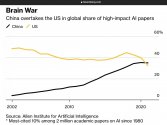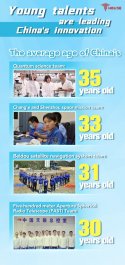You are using an out of date browser. It may not display this or other websites correctly.
You should upgrade or use an alternative browser.
You should upgrade or use an alternative browser.
News on China's scientific and technological development.
- Thread starter Quickie
- Start date
They can always ban something, screws and nuts for example.I read the article and could not get any idea what exactly the US will be banning to "stunt' Chinese quantum computing technology.
That is a reverse sanction, or self-sanction.Who knows, they may be mulling some "bans" on Chinese high-speed rail technology.
Last edited:
Imagine banning someone else's high speed rail technology when you don't even have one.Who knows, they may be mulling some "bans" on Chinese high-speed rail technology.
It would be utterly hilarious, but since we are talking about US politicians, so...
If they ban highspeed railway, that means they will not buy from China, or participate in any of China's BRI involving highspeed railway.Imagine banning someone else's high speed rail technology when you don't even have one.
It would be utterly hilarious, but since we are talking about US politicians, so...
China’s Communist Party looks to science cadres to help push back at US tech squeeze
- More scientists added to the top ranks of the party and military command
- Expertise ranges from rocket science to nuclear power and the environment
Meanwhile The US political duopoly party just keep adding lawyers to their top ranks.

Scientists from Tsinghua made the first 3D printer at the nanoscale resolution in the world. Their "printer" has the resolution of 20000 dots per inch. In comparison, regular laser printers usually print at 300 to 600 dots per inch.
News report in Chinese:
News release in Chinese by Tsinghua:
Paper published in English:
News report in Chinese:
清华团队实现激光3D纳米打印技术新突破
中国青年报客户端讯(中青报·中青网记者 叶雨婷 通讯员 李晓罡)记者从清华大学获悉,近日,清华大学精密仪器系孙洪波教授、林琳涵副教授课题组提出了一种全新的纳米颗粒激光3D打印技术,利用光生高能载流子调控纳米颗粒表面化学活性,实现纳米粒子间化学键合的三维装配。
研究团队在世界范围内首次应用了全新的打印原理并展示了多种不同纳米粒子的复杂三维结构和异质结构,在纳米粒子器件化领域实现了新的突破。这项技术实现了超越光学衍射极限的高精度激光微纳制造,打印点阵列密度超过20000ppi,为超高分辨功能器件的制备提供了新思路。
该成果于近日发表在《科学》(Science)期刊上,题为“光激发诱导化学键合实现半导体量子点3D纳米打印”。
据悉,纳米科学与技术作为21世纪最热门的研究领域之一,对当前集成化、智能化发展有着重要推动作用,无论是在先进电子设备,还是生物医学检测等领域,都随处可见纳米技术的应用。
当然,这些前沿应用背后的原理是基于材料尺寸减小至纳米尺度所产生的一系列奇特的物理、化学新效应,包括半导体材料中的量子限域效应与量子隧穿效应、金属材料出现的表面等离激元共振等。现有的纳米器件的制备主要基于光刻、电子束曝光等微纳制造技术,仅适用有限种类的纳米材料,并且作为平面化制备工艺,难以实现纳米材料的三维制造。
而另一方面,利用化学合成可以实现丰富多彩(不同尺寸、形貌、成分)纳米粒子的制备与精确裁制,并且这些纳米材料的晶体质量高、表面质量好,光、电、磁等多方面性能优越。然而这些化学合成的纳米粒子缺乏有效的器件化制备工艺,成为了其广泛应用的技术瓶颈。
针对以上难题,研究团队提出了光激发诱导化学键合的新原理,实现了纳米粒子的激光三维装配技术,以各种纳米粒子作为原料来组装三维纳米器件。以核壳结构的半导体量子点为例,利用激光激发量子点产生电子-空穴对,通过能级匹配,驱动光生空穴的隧穿和表面迁移,促使量子点表面配体脱附并形成活性化学位点,进而诱导量子点的表面化学成键,实现量子点之间的高效组装。
News release in Chinese by Tsinghua:
近日,清华大学科研团队在世界范围内首次研发应用了一种全新的纳米颗粒激光三维打印技术,可实现纳米材料复杂三维结构的精密成型。该技术有望推动虚拟现实技术(VR)、近眼显示等领域的发展,助力人们在元宇宙中实现高清畅游。
与现有的微纳加工制备技术相比,新技术利用更小的发光单元尺寸,更高的器件集成密度,赋予了三维纳米打印更多的“神奇特性”。清华精密仪器系副教授林琳涵介绍,该技术不需要任何光学粘合组分,实现了接近100%功能纳米粒子组分的三维打印,还能实现复杂线性、弯曲等多种三维纳米结构的高精度打印,用于构造新功能三维光电器件。
专业且高深的技术,可以提高虚拟世界的分辨率。“像素密度是衡量图像显示清晰度的标准,像素密度越高,图像拟真度就越好。”林琳涵介绍,一般激光打印机的输出分辨率是每英寸300至600个像素,印刷的照排机能达到每英寸1200至2400个像素。而团队研发的新技术利用非线性光激发,使打印分辨率突破光学衍射极限,打印点阵列密度超过每英寸2万像素,打印极限分辨率达到77纳米,有助于制造超高分辨率显示器件,让人们看到一个高清的虚拟现实世界。
“与学习知识与应用知识有所不同,很多从0到1的基础前沿研究应该是创造知识的过程。课题组在现有文献相对比较匮乏的情况下,做了大胆的猜测和假定,并通过实验验证和排除,最终得到并证实了新的机制。”林琳涵说,当下,科研项目、研究方向的选择有很多,团队会面向国家和社会的需求,继续做最有价值的前沿探索和技术攻关。
该成果由清华精密仪器系教授孙洪波、副教授林琳涵课题组完成,并于近日发表在了《科学》(Science)期刊上,题为“光激发诱导化学键合实现半导体量子点3D纳米打印”。
Paper published in English:
3D nanoprinting of semiconductor quantum dots by photoexcitation-induced chemical bonding
Abstract
Three-dimensional (3D) laser nanoprinting allows maskless manufacturing of diverse nanostructures with nanoscale resolution. However, 3D manufacturing of inorganic nanostructures typically requires nanomaterial-polymer composites and is limited by a photopolymerization mechanism, resulting in a reduction of material purity and degradation of intrinsic properties. We developed a polymerization-independent, laser direct writing technique called photoexcitation-induced chemical bonding. Without any additives, the holes excited inside semiconductor quantum dots are transferred to the nanocrystal surface and improve their chemical reactivity, leading to interparticle chemical bonding. As a proof of concept, we printed arbitrary 3D quantum dot architectures at a resolution beyond the diffraction limit. Our strategy will enable the manufacturing of free-form quantum dot optoelectronic devices such as light-emitting devices or photodetectors.
The fabrication of quantum devices and photonics devices, deposition is king and that is an area pretty understood in china.I read the article and could not get any idea what exactly the US will be banning to "stunt' Chinese quantum computing technology.
Who knows, they may be mulling some "bans" on Chinese high-speed rail technology.


